Brú na Bóinne - the archaeological ensemble of the Bend of the Boyne - Knowth: The Bend of the Boyne is situated on the north bank of the river Boyne in Ireland. The Bend of the Boyne is dominated by three large passage tombs: Newgrange, Knowth and Dowth. Knowth consists of a large passage tomb surrounded by 18 smaller satellite tombs. The large passage tomb or the Great Mound at Knowth was built approx. 5000 years ago. The Great Mound at Knowth contains two passages, each lead to a burial chamber. One of the passages leads to a burial chamber similar to that found at Newgrange. One of the things that makes Knowth special is the amount of kerbstones that feature megalithic art. Over 200 decorated stones were found at Knowth. The large passage tomb at Knowth is encircled by 127 kerbstones, most of them are decorated with megalithic art. Knowth was inhabited during the Late Iron Age and Early Christian Times. In the 9th and 10th centuries, Knowth was raided by Vikings several times. Visitors access is through the Brú na Bóinne Visitor Centre nearby the small village of Donore and by guided tour only. Visitors are advised to come as early in the day as possible, the number of visitors that can be accommodated at Newgrange and Knowth each day is limited. The Archaeological ensemble of the Bend of the Boyne became a UNESCO World Heritage in 1993. The name was changed in 2013: Brú na Bóinne - Archaeological Ensemble of the Bend of the Boyne. World Heritage Art: Bend of the Boyne
www.werelderfgoedfotos.nl © Copyright World Heritage Photos
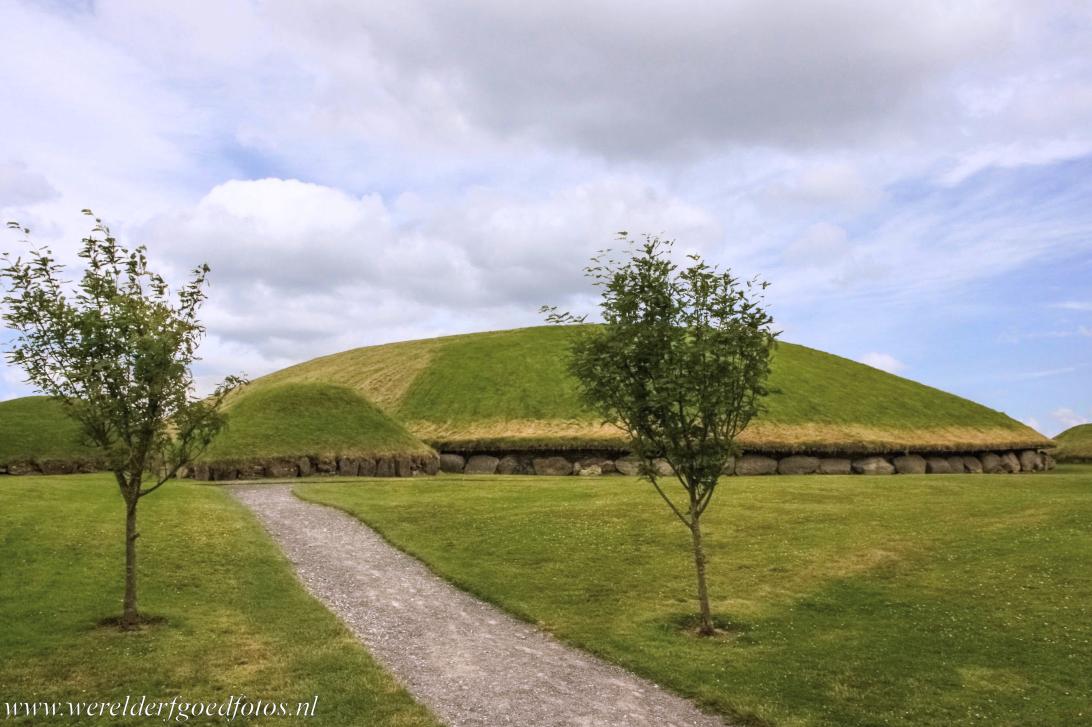
Brú na Bóinne - the archaeological ansemble of the Bend of the Boyne: The Great Mound is the largest passage tomb of Knowth. The large megalithic passage tomb at Knowth was built around 5000 years ago. Brú na Bóinne means the 'Palace or Mansion of the Boyne', the name is given to one of the most important archaeological landscapes in the world. The Bend of the Boyne is the most sacred and most mythical landscape of Ireland.

Brú na Bóinne - the archaeological ansemble of the Bend of the Boyne: The Great Mound is the largest passage tomb of Knowth. The large megalithic passage tomb at Knowth was built around 5000 years ago. Brú na Bóinne means the 'Palace or Mansion of the Boyne', the name is given to one of the most important archaeological landscapes in the world. The Bend of the Boyne is the most sacred and most mythical landscape of Ireland.
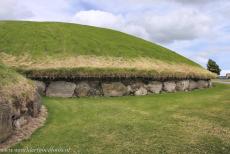
Brú na Bóinne - Archaeological Ensemble of the Bend of the Boyne: At least 18 smaller satelite tombs are located around the largest and central passage tomb of Knowth, at least two of them were built before the great mound of Knowth. In 1967 and 1968, archaeologists discovered two tombs within the central mound of Knowtk, one of the features of the tombs is the great wealth of megalithic art on the stones.
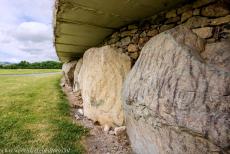
Brú na Bóinne - Archaeological Ensemble of the Bend of the Boyne: The large passage tomb at Knowth is encircled by 127 kerbstones. Most of these kerbstones are decorated with megalithic art. Only three kerbstones are missing. The Bend of the Boyne is situated on the north bank of the river Boyne. The site is dominated by three large passage tombs: Newgrange, Knowth and Dowth. Brú na Bóinne, the Bend of the Boyne was declared a UNESCO World Heritage in 1993.
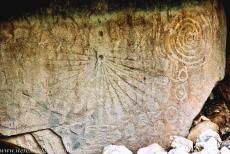
Brú na Bóinne - the archaeological ensemble of the Bend of the Boyne: The engraved kerbstone number 15 of the Great Mound at Knowth is known as the Sundial Stone or the Calendar Stone. There are more than 700 decorated stones in the Bend of the Boyne. Brú na Bóinne, the Bend of the Boyne is the largest and most important place of prehistoric megalithic art in Europe and one of the most important in the world.
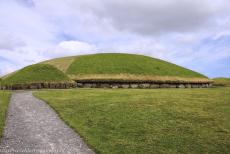
Brú na Bóinne - Archaeological Ensemble of the Bend of the Boyne: It is allowed to climb on the Great Mound, the largest passage tomb at Knowth. The view from the top is spectacular. From the top of the Great Mound at Knowth it is possible to see the Newgrange. Brú na Bóinne - the Archaeological Ensemble of the Bend of the Boyne, including Newgrange, Knowth, Dowth and numerous smaller passage tombs, was inscribed on the UNESCO World Heritage List in 1993.
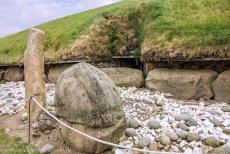
Brú na Bóinne - Archaeological Ensemble of the Bend of the Boyne: These two standing stones marks the entrance to the eastern passage of the Great Mound of Knowth. There are several standing stones outside the entrance of the passage tombs at Knowth. Newgrange is the most famous passage tomb in the Bend of the Boyne, but Knowth is the most impressive. One of the things that makes Knowth unique is the large number of engraved kerbstones.
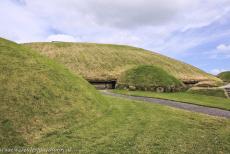
Brú na Bóinne - the archaeological ensemble of the Bend of the Boyne: The theory that the two passages of the large passage tomb at Knowth were aligned towards the sunrise and sunset on the spring and the autumn equinox has been found to be untrue. A new theory points towards a lunar function for Kowth. A number of the megalithic engravings on the kerbstones of Knowth could be the representations of lunar symbols and calculations.
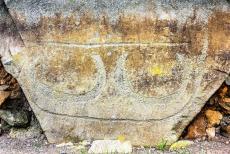
Brú na Bóinne - Archaeological Ensemble of the Bend of the Boyne: Kerbstone 86 of the Great Mound of Knowth. The kerbstones of Knowth are numbered clockwise by one of the excavators. Knowth has about 45 % of all the megalithic art found at the passage graves in Ireland and 30 % of all the megalithic art in Europe. Knowth is part of Brú na Bóinne - Archaeological Ensemble of the Bend of the Boyne. The Bend of the Boyne is considered the ancient capital of Ireland.
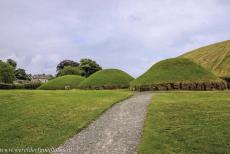
Brú na Bóinne - Archaeological Ensemble of the Bend of the Boyne: The Great Mound of Knowth is surrounded by several small passage tombs. Visitors access to Knowth is only by guided tour from the Brú na Bóinne Visitor Centre. There is no public access to Knowth by road. Visitors are brought from Brú na Bóinne Visitor Centre to the passage tombs by shuttle bus. Brú na Bóinne Visitor Centre is situated near the village of Donore in Ireland.
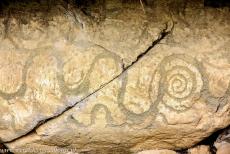
Brú na Bóinne - Archaeological Ensemble of the Bend of the Boyne: The decorated kerbstone 17 of the largest passage tomb or the Great Mound of Knowth. This passage tomb of Knowth is surrounded by 127 kerbstones, only three kerbstones are missing. The kerbstones of Knowth are numbered clockwise by one of the excavators. The Archaeological Ensemble of the Bend of the Boyne is situated on the north bank of the river Boyne near Donore in Ireland.
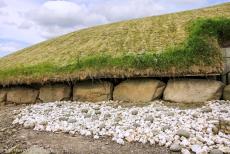
Brú na Bóinne - the archaeological ensemble of the Bend of the Boyne: One of the things that makes Knowth very special is the amount of kerbstones that feature megalithic art. There are a total of 261 kerbstones at Knowth. Over 200 decorated stones were found at Knowth. However, the most famous decorated stone of the archaeological Ensemble of the Bend of the Boyne is marking the entrance to the 5,000 years old passage grave Newgrange.
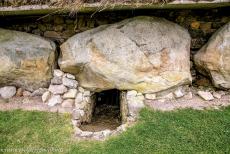
Brú na Bóinne - Archaeological Ensemble of the Bend of the Boyne: This underground room at Knowth was used to store food. In the Late Iron Age and Early Christian Times, the large passage tomb of Knowth became a hill fort. The Early Christians who lived at Knowth built underground rooms not only to store food, they were also used for hiding in case of danger. In the ninth and tenth centuries, Knowth was raided by Vikings at least several times.
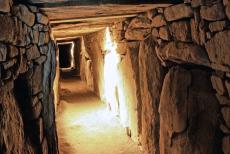
Brú na Bóinne - Archaeological Ensemble of the Bend of the Boyne: The Great Mound at Knowth contains two passages and each lead to a burial chamber. The eastern passage leads to a burial chamber similar to that found at the Newgrange passage tomb, the western passage leads also to a burial chamber. The two passages and burial chambers are not connected to each other. The eastern passage is 40 metres long, it is the longest megalithic passage in Western Europe.
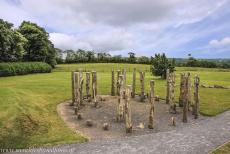
Brú na Bóinne - the archaeological ensemble of the Bend of the Boyne: The reconstruction of a timber circle at Knowth. The timber circle or woodhenge was originally built around 2,500 BC. The woodhenge was reconstructed using the 33 prehistoric post holes. The circle is situated at the eastern side of Knowth. Brú na Bóinne - Archaeological Ensemble of the Bend of the Boyne, including Knowth, was inscribed on the UNESCO World Heritage List in 1993.
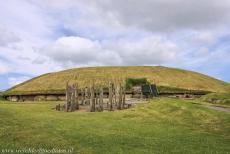
Brú na Bóinne - Archaeological Ensemble of the Bend of the Boyne: A reconstruction of a timber circle in front of the Great Mound at Knowth. The circle was Probably used for ritual ceremonies because several votive offerings were found in and around the timber circle, the woodhenge. In the Late Iron Age and in Early Christian Times, Knowth became a fortified hill, a wide moat was dug around Knowth. On the top are the foundations of medieval farm houses.
